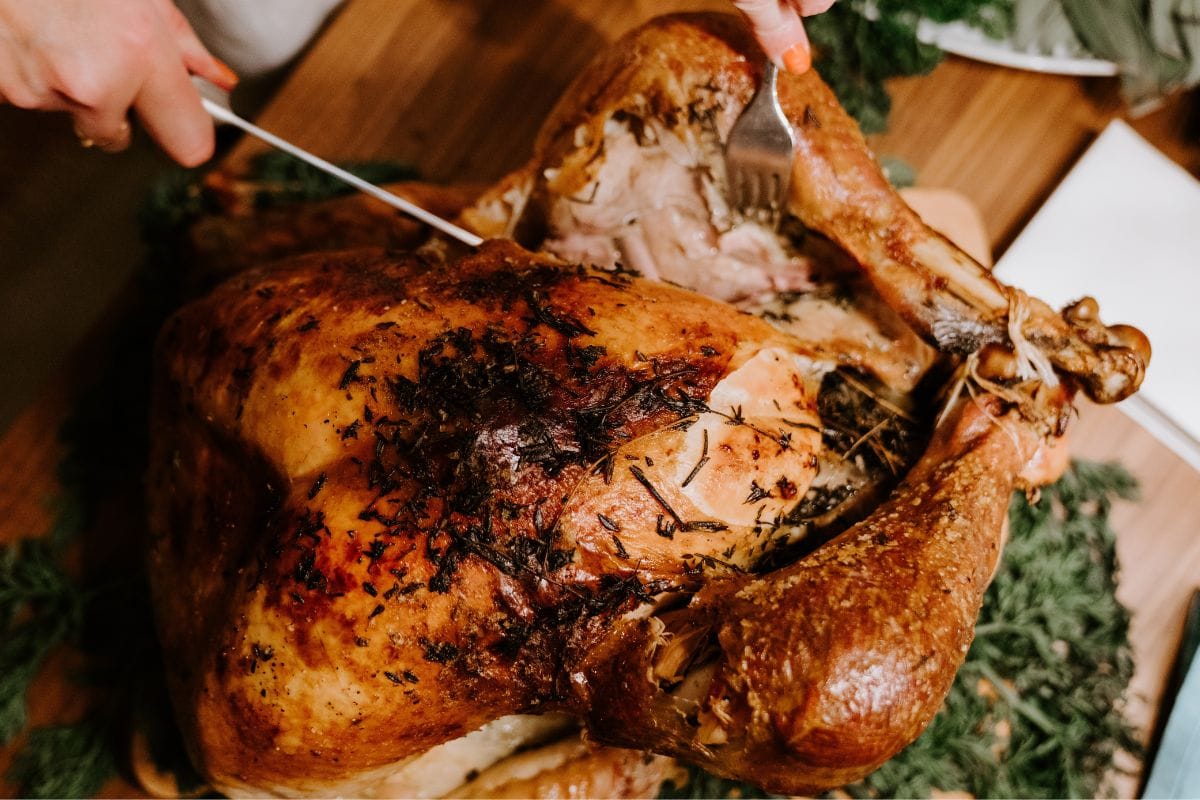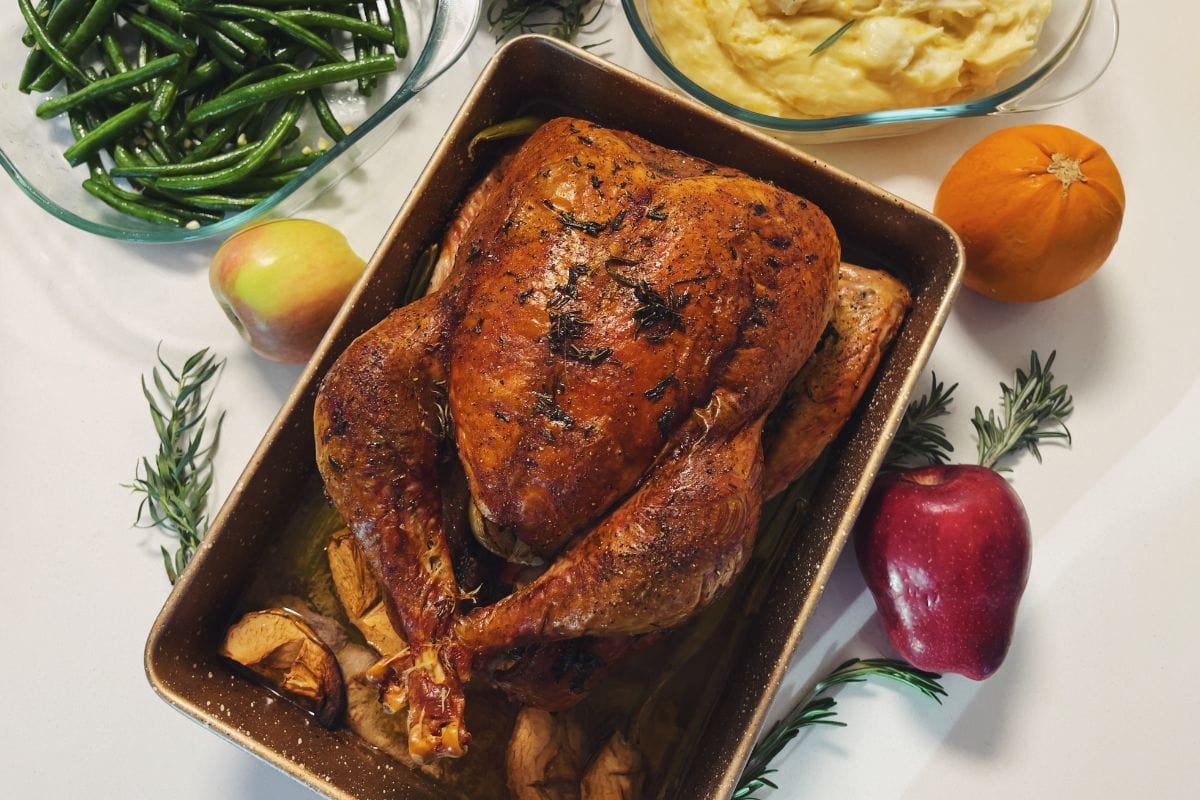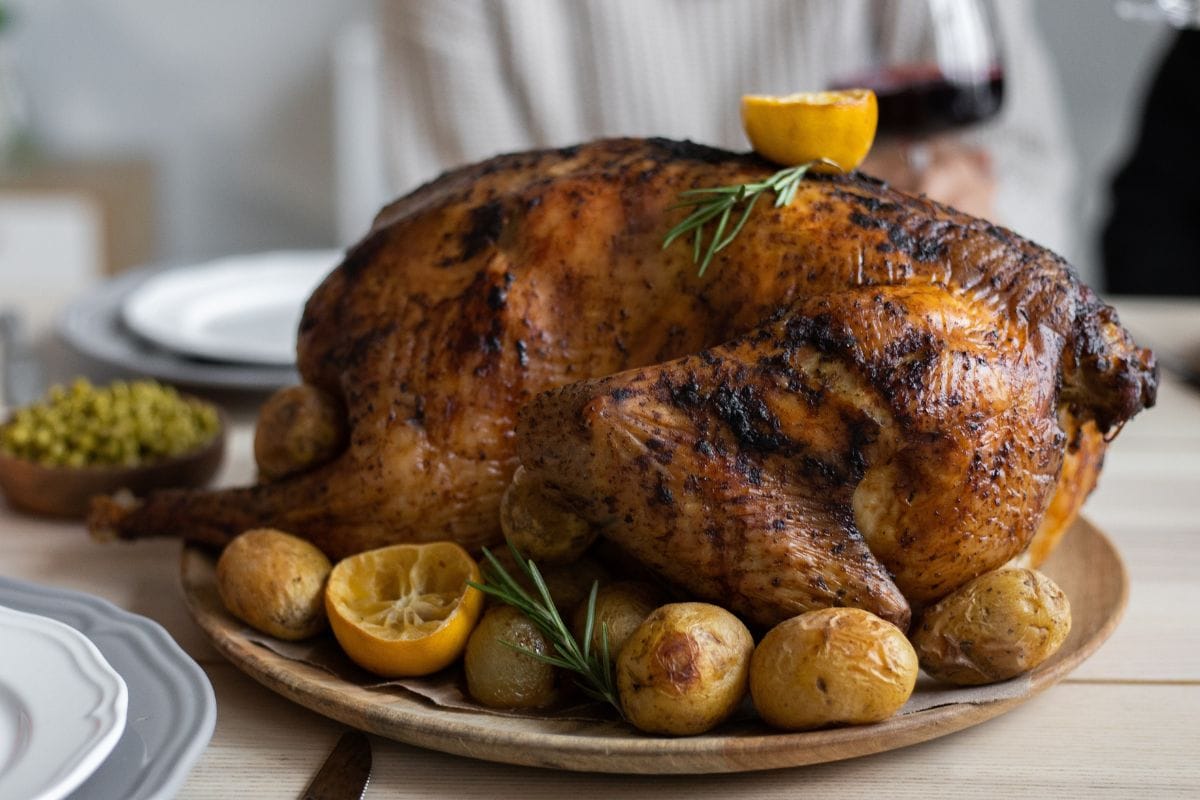A turkey is generally done at 165 degrees. A turkey cooked to 180 degrees is also done, but the meat may be overcooked. Turkey contains white and dark meat that can be done at 165- or 180 degrees cooking.
I learned the ideal temperature to cook turkey in cooking school, and I’ve managed to cook this tasty bird perfectly ever since. Over the years, this technique has worked for me and I guarantee they’ll work for you too. Read on as I further break down the pressing question: is turkey done at 165 or 180?

Turkey meat contains both white and dark meat and they cook differently at various temperatures.
165°F is my ideal doneness temperature for white or dark meat, even though some chefs cook dark meat for a little longer to get more tender results.
Bear in mind that you shouldn’t cook turkey breast meat or other parts of white meat to 180°F or it will be overdone. On the other hand, turkey legs and thighs will still taste perfect at 180°F.
Why? Legs and thighs are dark meat, which contains more connective tissue and muscles than white meat. So, even at a temperature of 180°F, the dark meat will taste juicy. The thigh meat of a lot of turkeys is cooked until it reaches a temperature of 180°F.
The turkey’s internal temperature helps indicate how tender it is. As you cook your turkey under heat, the muscles and proteins slowly break down. As the meat continues to break down, amino acids are released, giving the meat its distinct flavor and texture.
If you stop cooking the meat before it reaches the correct temperature, the proteins in the meat won’t have enough time to disintegrate, leading to a bland and tough piece of meat.
You also risk exposing yourself to food poisoning because the bacteria in the meat may not be fully eliminated. In comparison, if the meat is cooked past its recommended temperature, it will lose all its moisture and have a grainy texture.
The first step to reading a turkey’s temperature is to insert the meat thermometer in the thickest part of the bird. I recommend poking it in the center of the thigh meat or on the breast meat. For better results, leave the probe thermometer deep in the turkey’s skin.
Make sure you keep the thermometer away from the bird’s bones. The bones absorb more heat during the cooking process, so the probe touching them will give you a false reading.
There are many useful food thermometers you can use; however, I recommend using an instant-read thermometer. Remember to check the temperature several times to confirm it is done. With these tips, your turkey will come out perfect every single time.

There are a couple of reasons why your turkey may be pink. Trust me, pink meat doesn’t always indicate that the turkey is undercooked. Let’s look at three possible reasons why your turkey meat looks pinkish.
Even when cooked to 165 °F, poultry grilled outside can show pink juices. Grilled meat may have a pink hue due to the liquid and natural smoke flavor used in commercially processed turkeys.
The pink color in poultry can result from a chemical reaction between the heated gases and the hemoglobin present in the meat tissues.
Another reason your turkey has pink juices like undercooked food may be due to excessive amounts of myoglobin from insufficient denaturation during heat processing.
Younger birds typically show more pink color than older birds. This is because of their thinner skin and a small amount of fat.
These factors allow more heat to penetrate the turkey skin and expose the hemoglobin-filled bones to heat, causing the pink color to break down and spread to other parts of the meat.
Related Reading
Understanding which turkey parts are white meat and dark meat can help you better prepare this flavorful bird. White meat, or light meat, generally includes turkey breasts and wings.
On the other hand, the thighs and drumsticks make up most of the dark meat found on a whole turkey. That said, if you carve a fully cooked turkey, you’ll find some other dark meat areas, such as the meat near the ribs or underneath the breast meat.
The formation of either white or dark meat depends on the work that the bird’s muscles undergo.
Frequently exercised muscles, like those in a turkey’s legs, receive more iron and oxygen. These substances help produce more myoglobin, which gives muscle fibers their darker color and tougher texture.
In comparison, white meat comes from more dormant muscles, like turkey breasts. These areas consume less oxygen and make less myoglobin, so they appear lighter and feel more tender.
A turkey is considered undercooked if the temperature is below 165°F. If you’ve undercooked this delicious bird, don’t fret, you haven’t ruined Thanksgiving dinner. Simply allow the turkey to cook for longer. However, it’s not as easy as putting the whole bird in the cooker; you need to be more detailed.
If you place the entire bird in the cooker, you’ll considerably increase the cooking time; leaving your hungry guests waiting for longer.
More importantly, you risk overcooking parts of the bird that were already cooked or close to being done. By the time the undercooked portions reach 165°F, the tenderer parts will have already been overcooked.
Instead of putting the entire turkey in the cooker, set your oven to 375°F and allow it to preheat for a while.

Next, cut the turkey into pieces and place them on a roasting pan covered with a baking sheet. Then put this in the oven.
Here’s the challenging part: You need to check the temperature of each piece of the turkey’s carcass. This is because these pieces will have different levels of doneness depending on whether they are white or dark meat.
I suggest taking the readings every 10 to 15 minutes. Then, take out the part where the temperature reaches the recommended 165 degrees. Once all parts are cooked, remove the pieces of turkey from the oven and let them rest for 10 minutes before serving.
Undercooked turkey contains harmful bacteria that will make you sick.
You may experience symptoms of food poisoning, including fever, nausea, exhaustion, stomach discomfort, diarrhea, and other uncomfortable illnesses.
These symptoms tend to appear a day or two after you eat the raw meat. However, you may experience the symptoms earlier in more serious cases. If you fear that you’ve eaten undercooked meat, contact your doctor immediately.
You can always reheat your juicy turkey leftovers and enjoy them the following day. Simply preheat the oven to 325 degrees and heat it up till the meat reaches 165 degrees Fahrenheit. Note that it’s crucial to store your leftovers properly to preserve their unique taste.
That’s all there is to it! Hopefully, you now know the answer to: is turkey done at 165 or 180? Your flavorful turkey meat can be cooked to 165 or 180 degrees. Just be careful when cooking it past 165 degrees. Remember to follow my tips for reading the turkey temps, and you’ll never make an undercooked or overcooked turkey again!